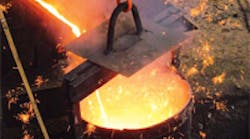During melting, small, carefully calibrated amounts of metallurgical additives are poured into the molten metal as it waits in the ladle. Determining the exact quantities of these additives for each batch by weighing the ladles is one application for specialized crane scales in foundries.
Another common metalcasting application for crane scales is to determine the volume of metal in the ladle, to prevent waste or potential damage caused by excess molten material in the ladle.
Crane scales in a foundry not only help to reduce costs and increase efficiency: They also increase safety by helping to prevent dangerous overloads.
The heat in a foundry melt shop requires special designs for a crane scale to function reliably. The “hottest” task for a scale is weighing the ladle full of molten metal. If it contains molten steel, the temperature of the load will exceed 1,800°F, and the direct radiation of heat is a significant factor in the scale’s performance. There is little chance for an extension cable to perform in such a setting, or even to survive. Usually, an extension cable is needed when using a remote readout, meaning that the crane should be outfitted either with a large display integrated with the load cell; or, a remote, wireless (RF) indicator.
The former is not popular because there are critical times when reading the scale is essential, and rising smoke frequently obscures the display in a way that makes it impossible to read the weight. In these circumstances, the problem is solved by using a crane scale with wireless remote display.
A different problem is the effect of temperature increases inside the load cell, another effect of the high ambient temperatures. As with the other critical equipment used in foundries, these devices must be designed with enough insulation so that the internal temperature remains as low as possible. Crane scales are typically supplied with a heat shield, which is a partial solution as it delays the temperature increase within the load cell, where the RF transmitter and other electronic elements are located. This shield will delay the rise in internal temperature, but it will not prevent it.
One crane scale designed specifically for the high-temperature demands of metalcasting operations is the RON 2501 wireless device offered by RON Crane Scales (www.ron-crane-scales.com), which offer a temperature range of 14° to 175°F, and a unique, load-cell internal thermometer. The thermometer enables the user to know the temperature inside the load cell, which is essential information for optimal operator control of the ladle-weighing process.
“These are the only systems on the market that we’ve been able to find that withstand the high-temperature environments in foundries,” confirms one veteran foundry operator. “We’ve been using them for at least the past five years. We recommend them to anyone looking for a crane scale that will work in these extreme environments.”
Other design advantages of the RON Crane Scales line include alternate power-supply options (main or disposable, 1,500-hr batteries); RS-232 for communication with PC or printer; integral data logger to record up to 6,000 data points, and present them as detailed reports with measurement time/date; a totalizer that displays the accumulated load; a 4-in. LED display; and set-point measurement.
Satisfied customers applaud the scales’ safety advantages — “Having the wireless system has enabled us to safely monitor loads in our castings plant from a safe distance,” reports one; as well as their simplicity — “One person can hook them up in a matter of minutes, and with the internal thermometers, it allows us to monitor the temperatures from quite a distance, to enable us to pull the load cell away from the heat for cool down periods. It takes out all the guess work,” another states.
Excerpted from FM&T March 2007 issue, pg. 37.










